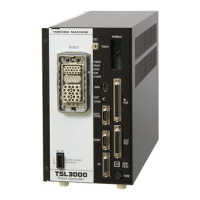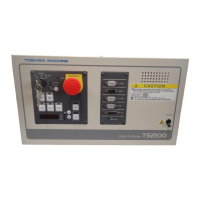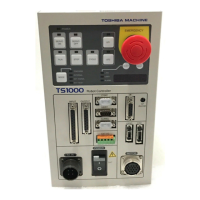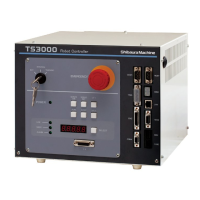
Do you have a question about the Toshiba TSL3000 and is the answer not in the manual?
| Brand | Toshiba |
|---|---|
| Model | TSL3000 |
| Category | Controller |
| Language | English |
Explains the procedure and precautions for turning on the main power of the TS3000 controller.
Describes the process and safety considerations for turning off the servo power of the TS3000.
Explains how to turn off the main power of the TS3000 and associated precautions.
Covers the procedure and cautions for powering on the main power of the TSL3000.
Explains how to turn on the servo power and associated safety measures.
Details the process for turning off servo power and related safety precautions.
Describes how to turn off the main power and the necessary precautions.
Explains how to switch to and use the teaching mode for robot guidance and control.
Details the steps to launch the program editor for creating and modifying robot programs.
Explains how to view, add, delete, and edit positional data entries.
Outlines how to view, add, delete, and manage coordinate data entries.
Explains how to select the teaching mode to initiate test operations for program verification.
Explains how to execute a program one step at a time for detailed testing.
Details how to start program execution for test operations or restart interrupted programs.
Explains how to select and use the internal automatic mode for TS3000 controllers.
Explains how to select external automatic modes (EXT. SIG, EX. 232C, EX. ETHER).
Explains how to start external automatic operation via signals or data communication.
Describes how to display the robot's current position in various coordinate systems.
Explains how to select and manage work and tool coordinate systems.
Describes how to set or cancel the work coordinate system.
Explains how to set or cancel the tool coordinate system.
Explains how errors are indicated on the TS3000 and TSL3000 controllers, including buzzer and LEDs.
Describes how to display error codes and messages, including current and historical errors.
Explains the procedure for resetting errors after they have been corrected.












